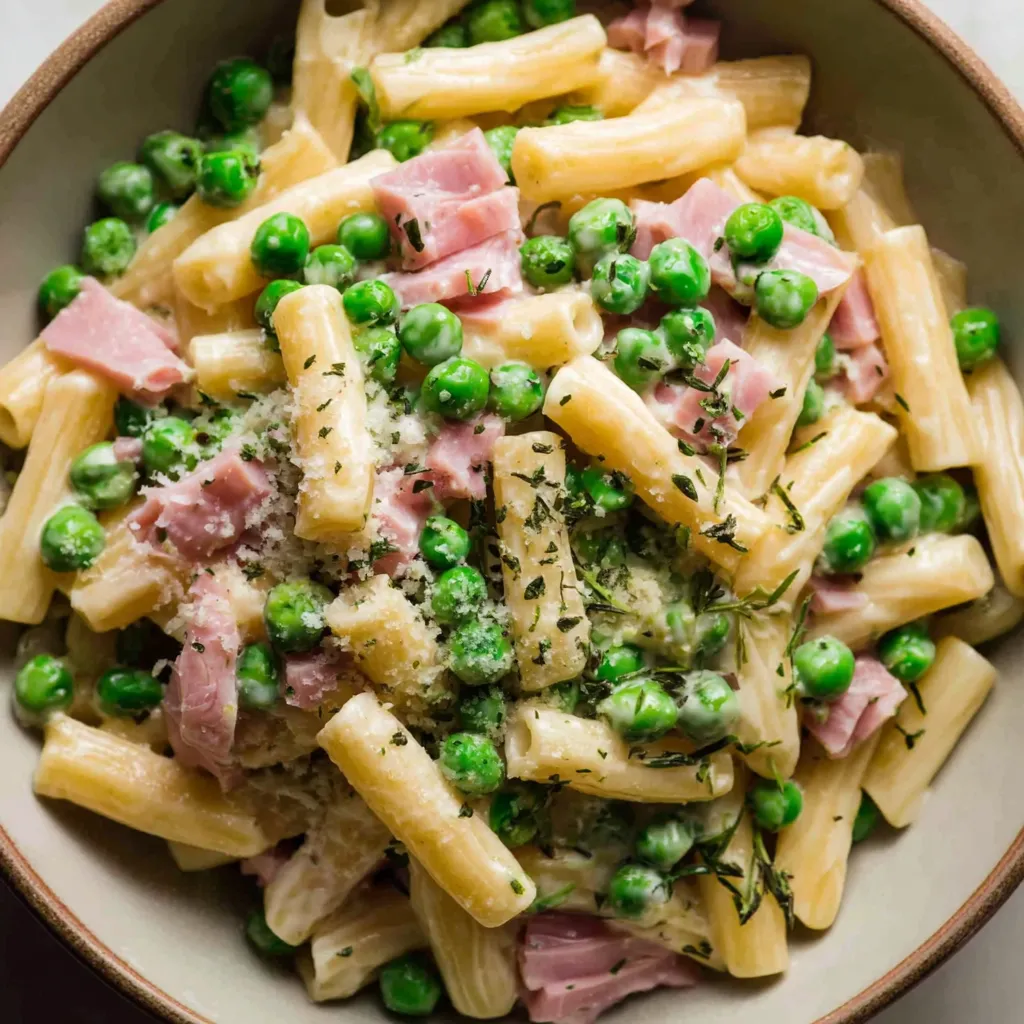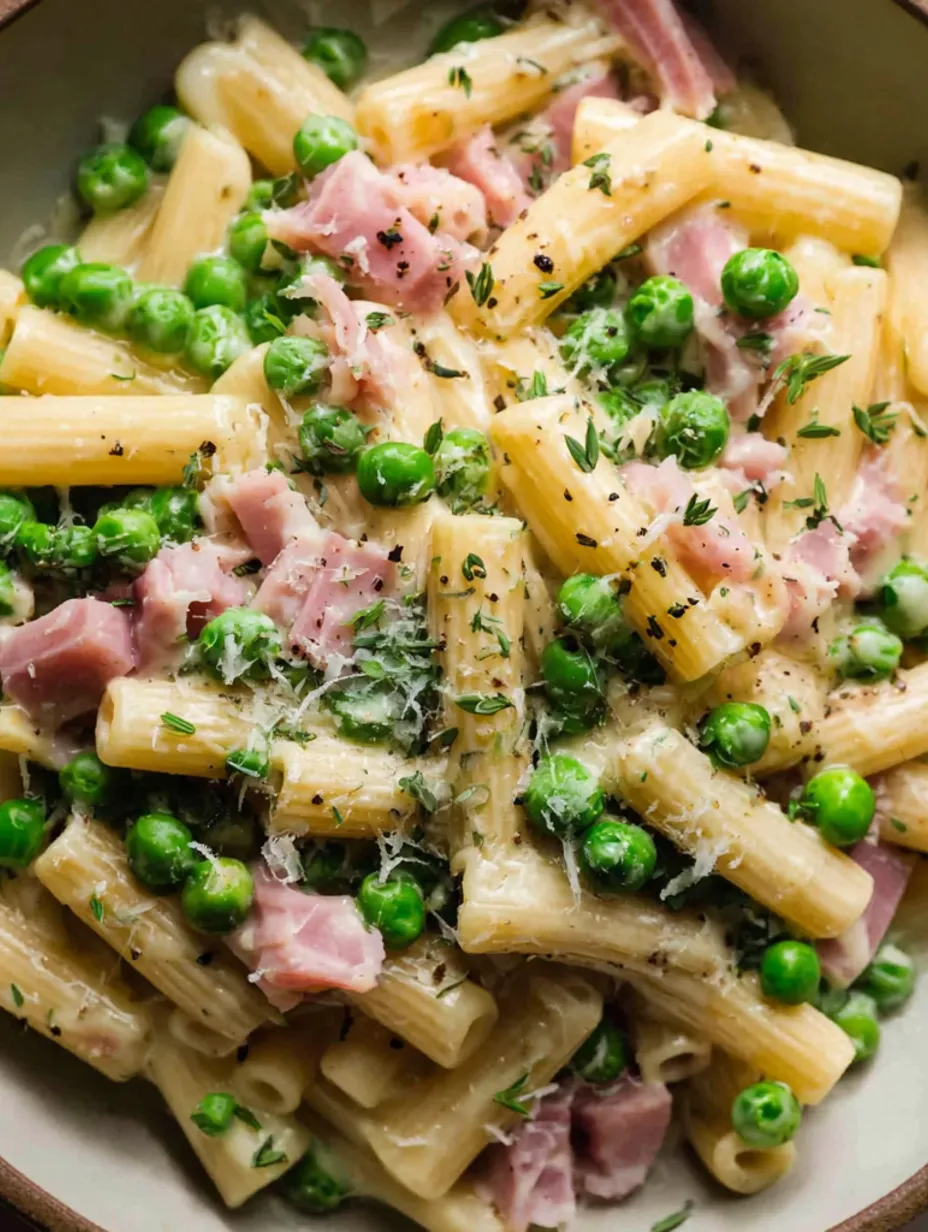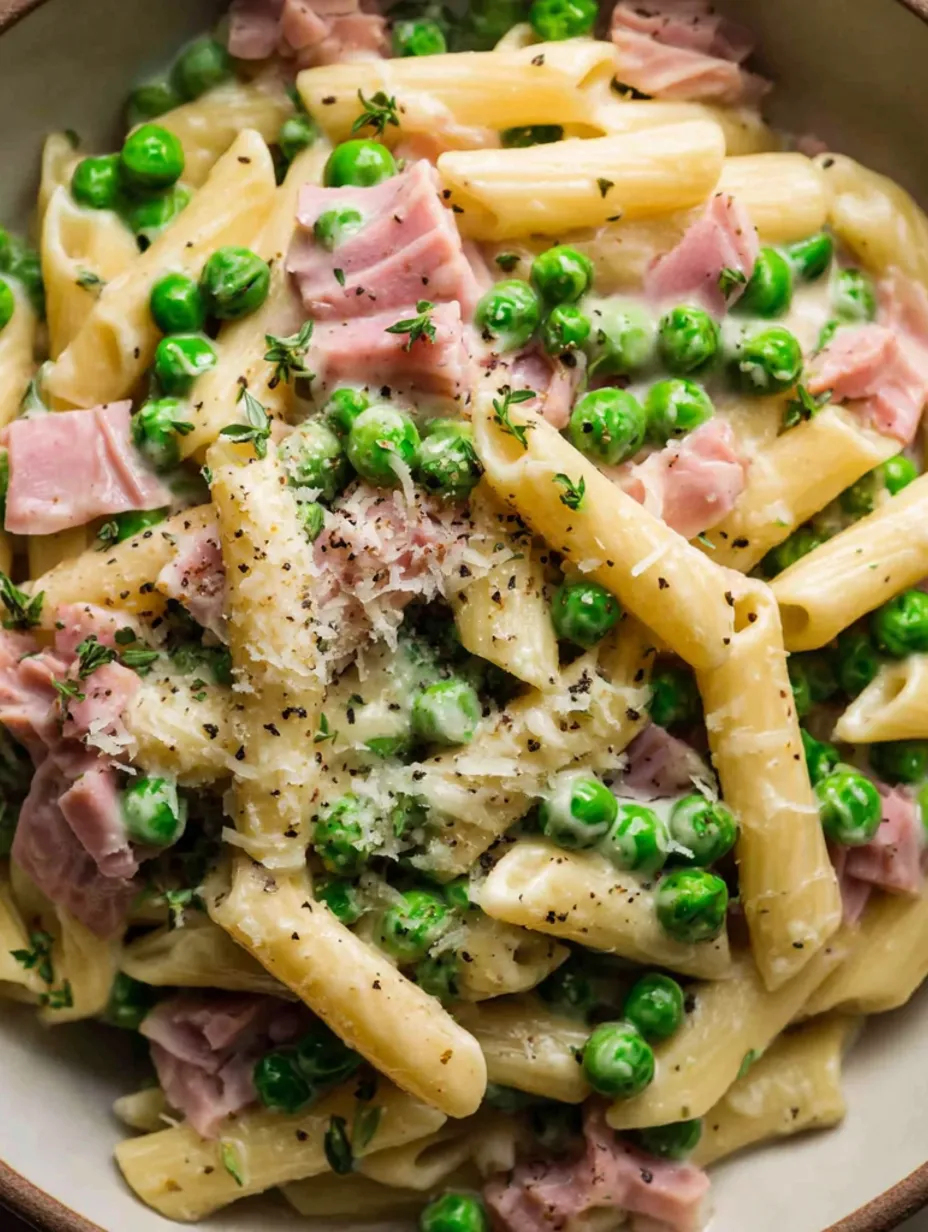 Bookmark
Bookmark
This creamy pasta with prosciutto cotto and peas is the kind of dish that feels like a warm hug after a long day. It is rich yet balanced, with the salty ham, sweet peas, and velvety cream sauce coming together in the most comforting way. I learned to make it when I lived in Emilia-Romagna, where it was everyone’s quick go-to dinner when time and energy were short, and it has been in my own rotation ever since.
I first cooked this on a night when I was too tired for anything complicated, and it instantly became one of those recipes that feels like it belongs in your back pocket forever. My kids now ask for it every time peas show up in the freezer.
Ingredients
- Unsalted butter: provides a rich base for sautéing onions and herbs
- Yellow onion: adds sweetness and depth to the sauce when cooked slowly
- Prosciutto cotto: gives a delicate salty flavor without overpowering the cream
- Fresh rosemary and thyme: bring earthy balance and fragrance
- Dry white wine: brightens the cream sauce with gentle acidity
- Heavy cream: creates the signature silky texture of the dish
- Nutmeg: adds subtle warmth and complexity to the sauce
- Frozen peas: deliver sweetness and color while being easy to keep on hand
- Dried penne rigate: holds the sauce well and gives the dish hearty bite
- Parmigiano Reggiano: adds sharpness and finishes the dish with richness
Step-by-Step Instructions
- Sauté the Aromatics:
- Melt the butter in a large skillet over medium heat. Add the finely chopped onion with a pinch of salt and cook gently for about 6 minutes until softened but not browned. This slow cooking draws out sweetness that forms the backbone of the sauce.
- Cook the Ham and Herbs:
- Stir in diced prosciutto cotto along with rosemary, thyme, and ground black pepper. Let the ham warm through for 4 minutes while the herbs release their fragrance into the butter and onions.
- Deglaze and Simmer the Cream:
- Pour in the white wine and allow it to reduce by half to concentrate flavor. Stir in the heavy cream and nutmeg, then bring to a gentle simmer. Let it reduce slightly for about 2 minutes until the sauce thickens. Keep the pan on low heat while preparing the pasta.
- Boil the Pasta:
- Cook penne rigate in salted boiling water until just shy of al dente, usually 2 minutes less than the package instructions. Reserve a cup of the cooking water before draining. This starchy water is key for finishing the sauce.
- Marry Pasta and Sauce:
- Transfer the pasta directly into the skillet with the cream mixture. Add half a cup of pasta water and cook over high heat, stirring until the sauce clings to the noodles. Add more cooking water in small amounts if needed until the sauce is silky and coats the pasta perfectly.
- Finish with Peas and Cheese:
- Remove the skillet from heat. Stir in thawed peas and grated Parmigiano Reggiano, mixing quickly so the peas warm through without overcooking. Taste and adjust seasoning with salt and pepper. Serve immediately while hot and creamy.
 Bookmark
Bookmark
Prosciutto cotto is my favorite part of this dish. Unlike the chewy saltiness of prosciutto crudo, cotto stays tender when cooked and infuses the sauce with just enough flavor. I remember my first trip to Parma, walking past deli counters stacked with whole hams, and realizing how much this one ingredient could transform a simple pasta into something luxurious.
Storage Tips
This pasta tastes best right after cooking, but leftovers can be kept in the refrigerator for up to five days in an airtight container. Reheat on the stovetop with a splash of water to loosen the sauce.
Ingredient Substitutions
If prosciutto cotto is unavailable, a thick cut of American-style ham steak works as a substitute, though you should season more lightly to avoid excess salt. Fresh peas can replace frozen ones in spring, but they should be blanched briefly before adding.
Serving Suggestions
This pasta pairs beautifully with a crisp green salad dressed simply with lemon and olive oil. For wine, a light Pinot Grigio or a dry Lambrusco echoes the Italian roots of the dish while cutting through the richness.
Cultural Note
In Emilia-Romagna, pasta prosciutto e piselli is as common as mac and cheese in the United States. It is a humble yet beloved dish, built from the staples of the region—ham, cream, cheese, and pasta—making it both comforting and a reflection of local abundance.
 Bookmark
Bookmark
Frequently Asked Questions About Recipes
- → What is the difference between prosciutto cotto and crudo?
Prosciutto cotto is cooked ham that's milder and less salty than prosciutto crudo (dry-cured). Cotto works better in cooked dishes as it doesn't become tough or overly salty when heated, making it ideal for pasta sauces.
- → Can I substitute regular ham for prosciutto cotto?
Yes, American ham steak works as a substitute, but use less salt when seasoning since it's typically saltier than Italian prosciutto cotto. Ask for a thick piece at the deli counter to dice at home.
- → Should I use fresh or frozen peas?
Frozen peas are actually preferred as they're picked at peak freshness and maintain better texture. If using fresh peas, blanch them briefly in the pasta water before adding to the dish.
- → How do I prevent the cream sauce from breaking?
Keep the heat at a gentle simmer when reducing the cream, and gradually add pasta water to help emulsify. The starchy pasta water helps bind the sauce and prevents separation.
- → Can this pasta be made ahead of time?
This dish is best served immediately for optimal texture. Leftovers can be refrigerated for up to 5 days and reheated gently with a splash of water to loosen the sauce.
- → What wine pairs best with this creamy pasta?
A crisp white wine like Pinot Grigio or Sauvignon Blanc complements the rich cream sauce beautifully. The same wine used for cooking works perfectly for serving alongside the dish.
